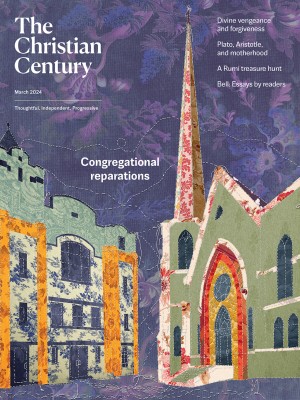March 29, Good Friday (John 18:1–19:42)
On the cross, the God-man who has repeatedly declared “I am” now begins to say that he is not.
John’s purpose in writing his gospel is to show us that Jesus is the Messiah, the Son of God. The stories he chooses and the structure of the text demonstrate that intent. In this gospel, Jesus often moves like a superhero, walking on water and moving himself and a boat full of disciples across the water at super speed. Sometimes, he mysteriously makes his way through crowds and eludes the capture of an active contingent against him. He moves like someone not from this world.
Then there are the seven signs, which we might otherwise call miracles. John deems them “signs” because they point us toward the messiahship of Jesus. Seven signs: one that keeps the party going, one that heals someone of some means, one that heals someone who has been suffering for decades, one that feeds the multitude, one that has him defying gravity and physics, one that shows how he pushes back against tradition by healing someone born a certain way, and then by demonstrating power over death itself by bringing Lazarus back to life. Seven signs, a complete picture of a Messiah with some otherworldly and supernatural power and promise.
Read our latest issue or browse back issues.
Yet John determines that all this is not enough for us to know who Jesus is. He brings the point home by making sure we hear Jesus’ “I am” statements, too. “I am” is a phrase that directly invokes a connection to the God who meets Moses at the bush, who empowers a liberatory revolution for the Israelite people. John is crafting this story, giving us this angle on Jesus that will make the readers of his gospel understand that Jesus is the Messiah. Seven “I am” statements, seven signs, and supernatural movement: by the time the reader gets to the cross, there is to be no confusion about the divinity of Jesus.
Yet when we get to the cross, John lets us peer into a different aspect of Jesus’ being. The God-man who has given seven signs and repeatedly declared “I am” now begins to say he is not.
The three statements that John offers us from Jesus on the cross are decidedly “I am not” statements. First, “Behold your son! . . . Behold your mother!” It’s a promise given to his mother and his disciple about a continued connection after his departure. Jesus is the I Am, but he can’t continue to care for those he loves once he departs. Then there’s “I thirst,” just one word in the Greek: dipso. Jesus walked on water during his ministry, but here at the end he is parched and in need of water—he physically can’t sustain this pain without some help. And lastly, “It is finished,” another one-word declaration, tetelstai. Jesus’ life, his energy, his ability to press on has reached its end: he is done, physically unable to continue. For a gospel that is deeply concerned with describing a deity, the end is decidedly human.
These words from the cross offer a beautiful complement to the “I am” statements of John’s Gospel. Making sure that your mom and disciple are well, being honest about your thirst and your exhaustion—Jesus is exclaiming from the cross that he is not perfect, not invincible, not without needs, not a superhero. It’s as if he is saying, I am not the bread of life, I’m crumbs brushed away after you’ve finished eating. I am not the light of the world, I’m the last flicker before the battery dies. I am not the gate, I’m the broken lock that’s hanging on by a thread. I am not the Good Shepherd, I’m the sheep that’s been taken to slaughter. I am not the resurrection and the life, I’m the crucifixion and the death. I am not the way, the truth, and the life, I’m the dead end. I am not the true vine, I’m the wilted branch ready to be pruned.
Jesus is both the I Am and the I Am Not. And his time on Golgotha’s hill reminds us that all that power does not shield him from suffering or pain.
Our lives are also full of “I am” and “I am not” moments. We will know times of great success, joy, and victory. We will know times of defeat, suffering, and pain. But when we are honest about our “I am not” moments the community can help us. Jesus could not take care of his mother and his disciple anymore, but when he expressed that need they found each other. Jesus could not contain his thirst anymore, but once he expressed his need someone came to his aid. We will always live in the tension between “I am” and “I am not.” The gift of being a part of the church is that we always can.





